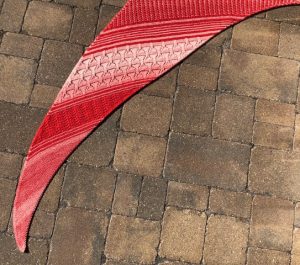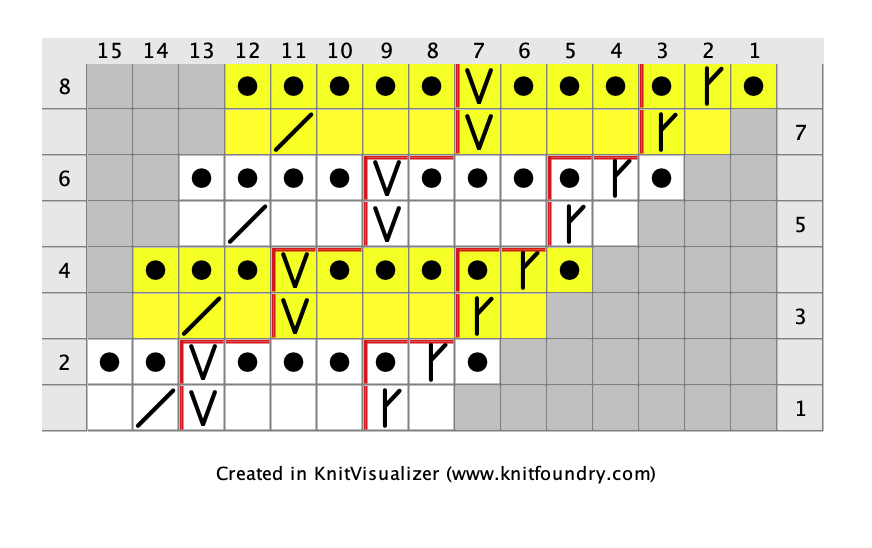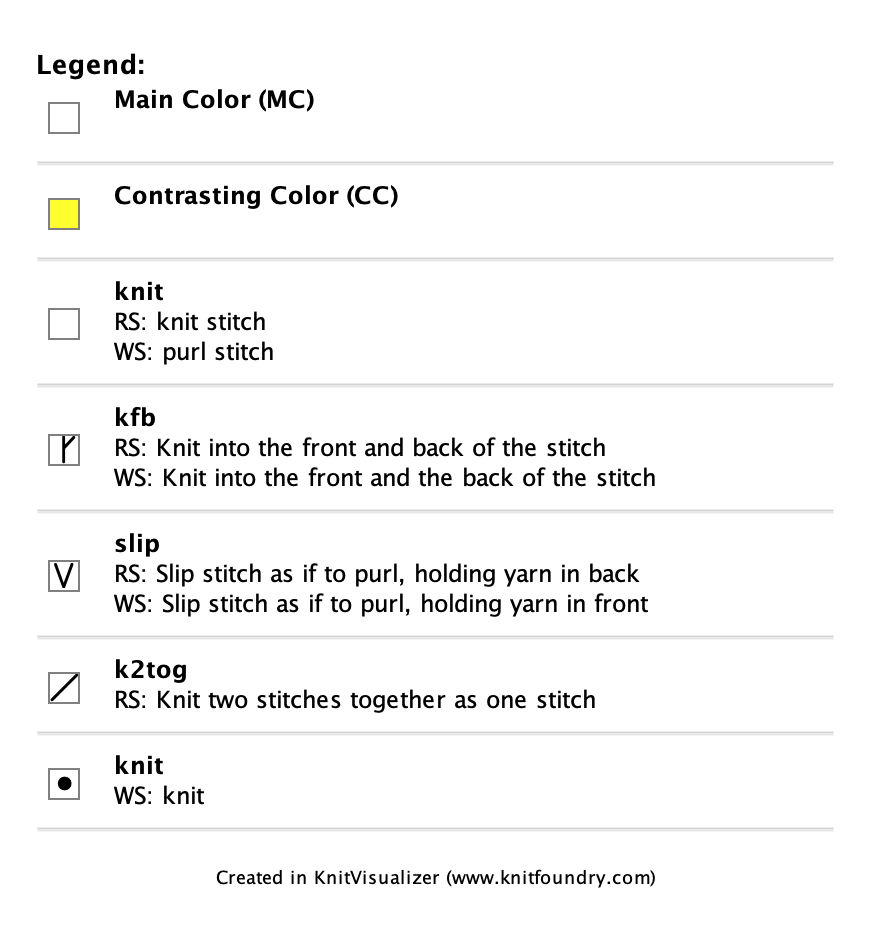Our shawl is taking shape nicely and I’m excited to share a new stitch pattern with you!
Section #6
Another section of striping is added here to separate the stitch patterns. This section’s striping is deeper to balance the proportions of Sections 5 and 7. This is simple garter stitch maintaining the same increase pattern. Be sure to pay close attention to the correct color used in each row as you continue to carry the yarn up the side.
I joined my second skein of Contrasting Color in Row 28 of this section. There are several ways to join and weave in yarn. The Russian Join (see video) may be used mid-row and eliminates the need to weave in ends. Starting a new skein at the beginning of a row or mid-row can be accomplished by simply dropping the old yarn and beginning with the new skein. The resulting tails can be woven in on the wrong side invisibly using my Weaving in Ends – Garter Stitch video.
Section #7
A fun-to-work slip stitch tweed graces this section. Slip stitch patterns are the most common variety of color work designs. Because these patterns use only one color per row, they are often the simplest and quickest to knit. While one yarn is working across a row, the alternate color remains connected to the work but rests along the side until needed. In each row the working yarn is carried across the slipped stitches, producing strands for a dense and firm fabric.
Slipping a stitch simply moves the stitch from the left hand needle to the right hand needle without working it. The conventional rule in knitting is to slip a stitch as if to purl with the yarn held to the wrong side, unless otherwise stated. This basic principle results in the slipped stitch sitting correctly on the right hand needle and the working yarn (strand) hidden on the wrong side. Section #7’s Three-and-One Tweed adheres to this rule.
This section continues with one stitch increased on every wrong side row as seen throughout the shawl. Four stitches are increased in every eight-row repeat and I provide these stitch counts at the end of each repeat. The tweed section is worked seven times ending after Row 56. Cut the CC yarn as it will not be used in Section #8.
The chart for Section #7 works as in the previous charts. Rows 3, 4, 7 and 8 are shown in yellow and are to be worked in the Contrasting Color. If printing the chart in black and white, be sure to use a yellow marker to highlight these rows.
Depending on your tension, the stripes in Section #6 may ruffle up a bit next to the tweed pattern. This slight disturbance will disappear with blocking.
We return next week to finish the shawl and end with a bang!
Happy knitting,
Michelle
Part Three
Click here to download printable copy
Abbreviations
CC – contrasting color.
k2tog – knit two together. See K2tog Video
kfb – knit into front and back of stitch. See Kfb Video
MC – main color.
sl – slip. See Slip Stitch Video
wyib – with yarn in back.
wyif – with yarn in front.
Instructions
Section #6 (MC and CC)
Row 1. (RS) With CC, k1, kfb, knit to last 3 sts, k2tog, k1.
Row 2. (WS) With CC, knit to last 2 sts, kfb, k1. 115 sts
Row 3. With CC, same as 1.
Row 4. With CC, same as 2. 116 sts
Row 5. With MC, same as 1.
Row 6. With MC, same as 2. 117 sts
Row 7. With MC, same as 1.
Row 8. With MC, same as 2. 118 sts
Row 9. With CC, same as 1.
Row 10. With CC, same as 2. 119 sts
Row 11. With CC, same as 1.
Row 12. With CC, same as 2. 120 sts
Row 13. With MC, same as 1.
Row 14. With MC, same as 2. 121 sts
Row 15. With CC, same as 1.
Row 16. With CC, same as 2. 122 sts
Row 17. With MC, same as 1.
Row 18. With MC, same as 2. 123 sts
Row 19. With CC, same as 1.
Row 20. With CC, same as 2. 124 sts
Row 21. With MC, same as 1.
Row 22. With MC, same as 2. 125 sts
Row 23. With CC, same as 1.
Row 24. With CC, same as 2. 126 sts
Row 25. With MC, same as 1.
Row 26. With MC, same as 2. 127 sts
Row 27. With CC, same as 1.
Row 28. With CC, same as 2. 128 sts (Joined 2nd CC skein)
Row 29. With CC, same as 1.
Row 30. With CC, same as 2. 129 sts
Row 31. With MC, same as 1.
Row 32. With MC, same as 2. 130 sts
Row 33. With MC, same as 1.
Row 34. With MC, same as 2. 131 sts
Row 35. With CC, same as 1.
Row 36. With CC, same as 2. 132 sts
Row 37. With CC, same as 1.
Row 38. With CC, same as 2. 133 sts
MC = 85g, 2nd CC skein = 42g
Section #7 (MC and CC)
Three-and-One Tweed (See Chart below)
As above rows, one stitch is increased on each wrong side row (Four stitches are increased in each eight-row repeat.) Stitch counts provided at end of each repeat.
Row 1. (RS) With MC, k1, kfb, *k3, sl 1 wyib; repeat from * to last 3 sts, k2tog, k1.
Row 2. (WS). With MC, k2, *sl 1 wyif, k3; repeat from * to last 3 sts, k1, kfb, k1.
Row 3. With CC, k1, kfb, *k3, sl 1 wyib; repeat from * to last 4 sts, k1, k2tog, k1.
Row 4. With CC, k3, *sl 1 wyif, k3; repeat from * to last 3 sts, k1, kfb, k1.
Row 5. With MC, k1, kfb, *k3, sl 1 wyib; repeat from * to last 5 sts, k2, k2tog, k1.
Row 6. With MC, k4, *sl 1 wyif, k3; repeat from * to last 3 sts, k1, kfb, k1.
Row 7. With CC, k1, kfb, *k3, sl 1 wyib; repeat from * to last 6 sts, k3, k2tog, k1.
Row 8. With CC, k5, *sl 1 wyif, k3; repeat from * to last 3 sts, k1, kfb, k1. 137 sts
Rows 9 – 16. Same as 1-8. 141 sts
Rows 17 – 24. Same as 1-8. 145 sts
Rows 25 – 32. Same as 1-8. 149 sts
Rows 33 – 40. Same as 1-8. 153 sts
Rows 41 – 48. Same as 1-8. 157 sts
Rows 49 – 56. Same as 1-8. 161 sts
Cut CC. MC = 53g, 2nd CC skein = 11g
Section #7 – Three-and-One Tweed (MC and CC)
4-stitch repeat between red lines, work Rows 1 – 8 seven times (56 rows)




